
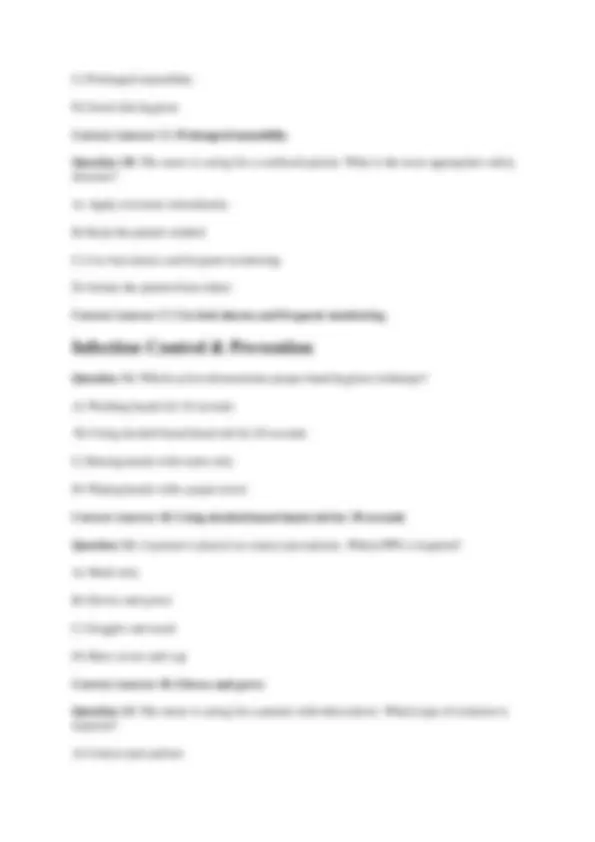
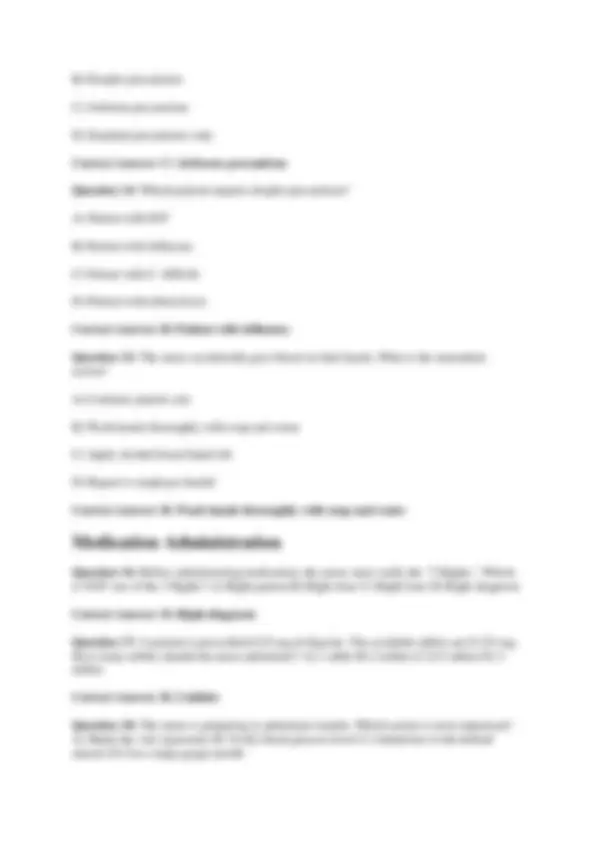
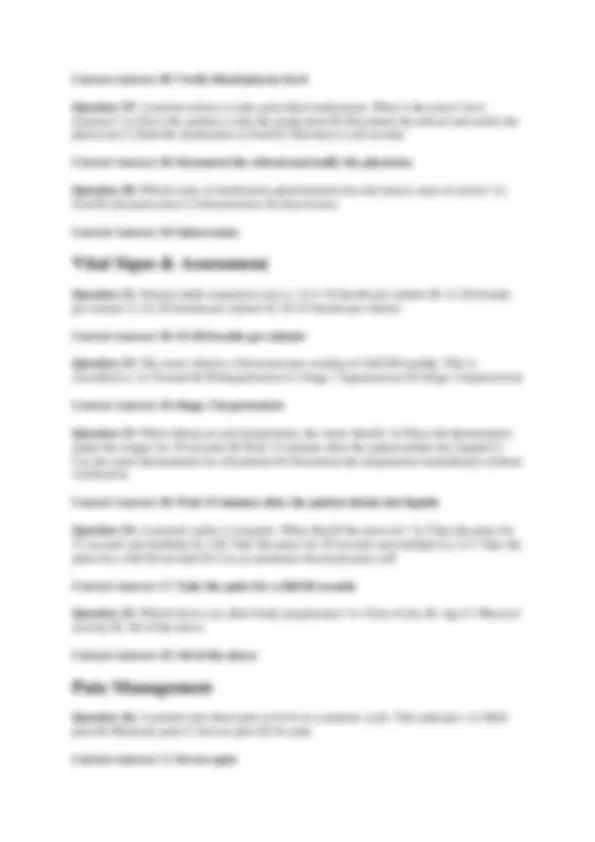
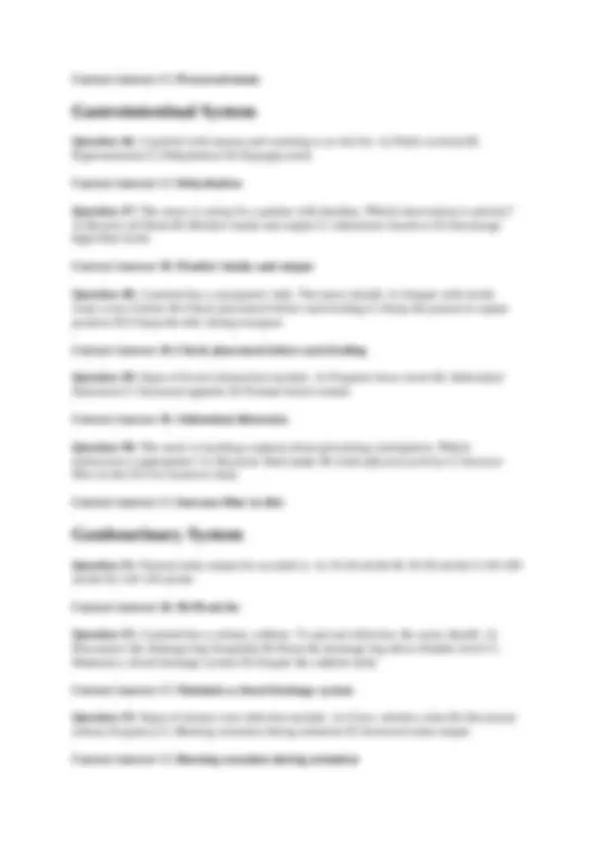
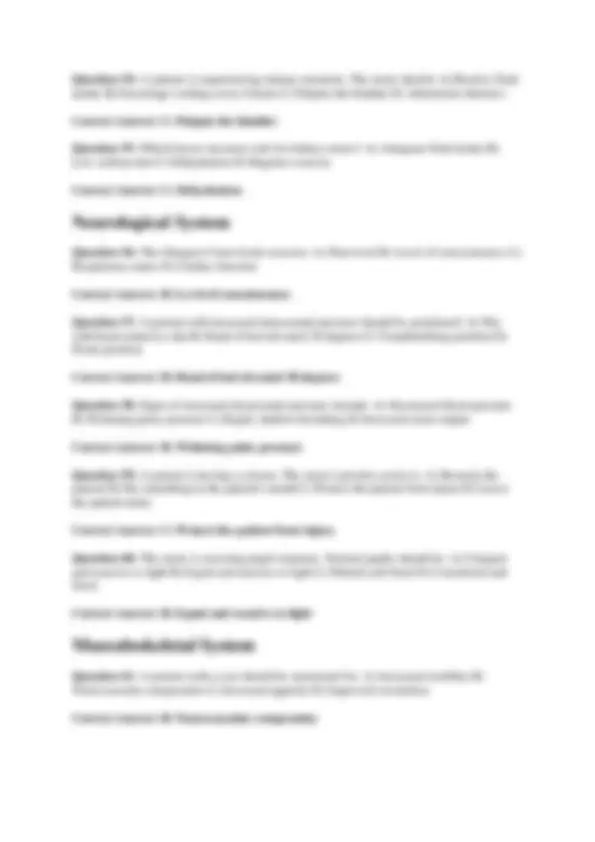
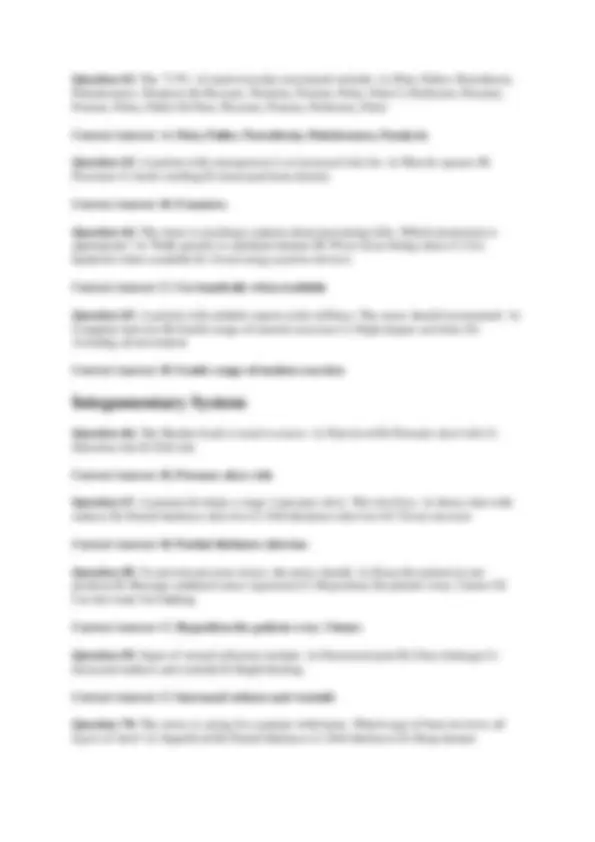
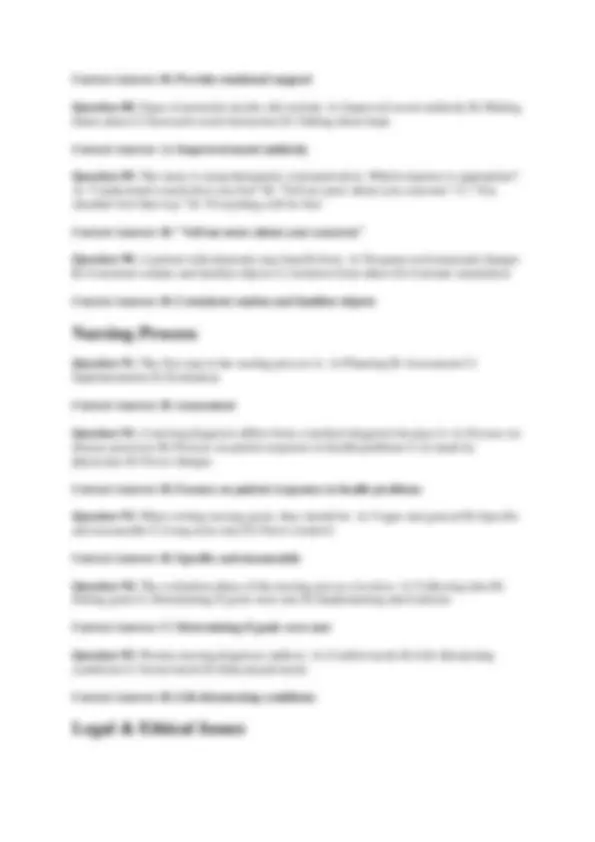
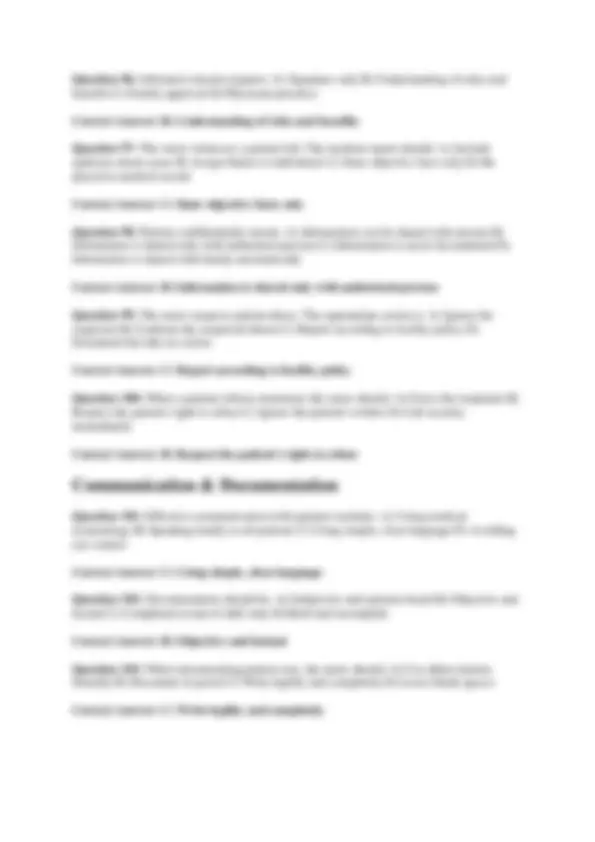


Study with the several resources on Docsity

Earn points by helping other students or get them with a premium plan


Prepare for your exams
Study with the several resources on Docsity

Earn points to download
Earn points by helping other students or get them with a premium plan
Community
Ask the community for help and clear up your study doubts
Discover the best universities in your country according to Docsity users
Free resources
Download our free guides on studying techniques, anxiety management strategies, and thesis advice from Docsity tutors
Comprehensive Nursing Exam Guide: NCLEX/ATI/HESI Prep. This in-depth resource covers every critical aspect of nursing exam preparation. With a wide range of practice questions and verified answers from leading nursing experts, you'll gain a thorough understanding of the material and build a strong foundation. Don't just study – master the concepts. Download this definitive guide and confidently conquer your nursing exams!
Typology: Exams
1 / 14

This page cannot be seen from the preview
Don't miss anything!









Question 1: According to Erikson's psychosocial development theory, what is the primary developmental task for a toddler (ages 1-3)? A) Trust vs. Mistrust B) Autonomy vs. Shame and Doubt C) Initiative vs. Guilt D) Industry vs. Inferiority Correct Answer: B) Autonomy vs. Shame and Doubt Question 2: The nurse is assessing a 6-month-old infant. Which developmental milestone should the nurse expect to observe? A) Walking independently B) Sitting without support C) Speaking in 2-word sentences D) Toilet training completion Correct Answer: B) Sitting without support Question 3: A 4-year-old child is hospitalized. According to Piaget's cognitive development theory, this child is in which stage? A) Sensorimotor B) Preoperational C) Concrete operational D) Formal operational Correct Answer: B) Preoperational Question 4: When caring for an elderly patient, the nurse understands that successful aging according to Erikson involves: A) Generativity vs. Stagnation B) Intimacy vs. Isolation C) Integrity vs. Despair D) Identity vs. Role confusion
Correct Answer: C) Integrity vs. Despair Question 5: A 15-year-old patient is struggling with peer relationships and self-identity. This represents which developmental stage? A) Initiative vs. Guilt B) Industry vs. Inferiority C) Identity vs. Role confusion D) Intimacy vs. Isolation Correct Answer: C) Identity vs. Role confusion
Question 6: Which patient would be at highest risk for falls? A) A 35-year-old with diabetes B) An 80-year-old on blood pressure medication C) A 50-year-old post-operative patient D) A 25-year-old with pneumonia Correct Answer: B) An 80-year-old on blood pressure medication Question 7: The nurse is implementing fall prevention strategies. Which intervention is most appropriate? A) Keeping the bed in the highest position B) Encouraging the patient to call for help before getting up C) Removing the call light to prevent overuse D) Keeping the room dimly lit at night Correct Answer: B) Encouraging the patient to call for help before getting up Question 8: A patient is prescribed multiple medications that can cause drowsiness. What is the nurse's priority intervention? A) Educate about medication side effects B) Implement fall precautions C) Monitor vital signs every 4 hours D) Encourage increased fluid intake Correct Answer: B) Implement fall precautions Question 9: Which factor increases a patient's risk for pressure ulcers? A) Adequate nutrition B) Frequent position changes
B) Droplet precautions C) Airborne precautions D) Standard precautions only Correct Answer: C) Airborne precautions Question 14: Which patient requires droplet precautions? A) Patient with HIV B) Patient with influenza C) Patient with C. difficile D) Patient with tuberculosis Correct Answer: B) Patient with influenza Question 15: The nurse accidentally gets blood on their hands. What is the immediate action? A) Continue patient care B) Wash hands thoroughly with soap and water C) Apply alcohol-based hand rub D) Report to employee health Correct Answer: B) Wash hands thoroughly with soap and water
Question 16: Before administering medication, the nurse must verify the "5 Rights." Which is NOT one of the 5 Rights? A) Right patient B) Right dose C) Right time D) Right diagnosis Correct Answer: D) Right diagnosis Question 17: A patient is prescribed 0.25 mg of digoxin. The available tablets are 0.125 mg. How many tablets should the nurse administer? A) 1 tablet B) 2 tablets C) 0.5 tablets D) 3 tablets Correct Answer: B) 2 tablets Question 18: The nurse is preparing to administer insulin. Which action is most important? A) Shake the vial vigorously B) Verify blood glucose level C) Administer in the deltoid muscle D) Use a large gauge needle
Correct Answer: B) Verify blood glucose level Question 19: A patient refuses to take prescribed medication. What is the nurse's best response? A) Force the patient to take the medication B) Document the refusal and notify the physician C) Hide the medication in food D) Threaten to call security Correct Answer: B) Document the refusal and notify the physician Question 20: Which route of medication administration has the fastest onset of action? A) Oral B) Intramuscular C) Subcutaneous D) Intravenous Correct Answer: D) Intravenous
Question 21: Normal adult respiratory rate is: A) 8-10 breaths per minute B) 12- 2 0 breaths per minute C) 22-28 breaths per minute D) 30-35 breaths per minute Correct Answer: B) 12-20 breaths per minute Question 22: The nurse obtains a blood pressure reading of 160/100 mmHg. This is classified as: A) Normal B) Prehypertension C) Stage 1 hypertension D) Stage 2 hypertension Correct Answer: D) Stage 2 hypertension Question 23: When taking an oral temperature, the nurse should: A) Place the thermometer under the tongue for 30 seconds B) Wait 15 minutes after the patient drinks hot liquids C) Use the same thermometer for all patients D) Document the temperature immediately without verification Correct Answer: B) Wait 15 minutes after the patient drinks hot liquids Question 24: A patient's pulse is irregular. What should the nurse do? A) Take the pulse for 15 seconds and multiply by 4 B) Take the pulse for 30 seconds and multiply by 2 C) Take the pulse for a full 60 seconds D) Use an automatic blood pressure cuff Correct Answer: C) Take the pulse for a full 60 seconds Question 25: Which factor can affect body temperature? A) Time of day B) Age C) Physical activity D) All of the above Correct Answer: D) All of the above
Question 26: A patient rates their pain as 8/10 on a numeric scale. This indicates: A) Mild pain B) Moderate pain C) Severe pain D) No pain Correct Answer: C) Severe pain
Question 36: A patient with COPD should be positioned: A) Flat on their back B) In high Fowler's position C) On their side D) In Trendelenburg position Correct Answer: B) In high Fowler's position Question 37: Normal oxygen saturation is: A) 85-90% B) 90-95% C) 95-100% D) 100% Correct Answer: C) 95-100% Question 38: A patient is using a metered-dose inhaler. The nurse should instruct the patient to: A) Breathe in quickly and shallowly B) Exhale completely before using C) Hold breath for 5 seconds after inhalation D) Use the inhaler every hour Correct Answer: B) Exhale completely before using Question 39: Signs of respiratory distress include: A) Use of accessory muscles B) Cyanosis C) Restlessness D) All of the above Correct Answer: D) All of the above Question 40: The nurse is suctioning a patient's airway. The suction should be applied for no longer than: A) 5 seconds B) 10-15 seconds C) 20 seconds D) 30 seconds Correct Answer: B) 10-15 seconds
Question 41: A patient with chest pain should be positioned: A) Flat B) Semi-Fowler's C) Trendelenburg D) Prone Correct Answer: B) Semi-Fowler's Question 42: Normal heart rate for an adult is: A) 50-80 bpm B) 60-100 bpm C) 80-120 bpm D) 100-140 bpm Correct Answer: B) 60-100 bpm Question 43: A patient is prescribed nitroglycerin for chest pain. The nurse should monitor for: A) Hypertension B) Hypotension C) Bradycardia D) Increased appetite Correct Answer: B) Hypotension Question 44: Signs of decreased cardiac output include: A) Warm, dry skin B) Strong peripheral pulses C) Fatigue and weakness D) Increased urine output Correct Answer: C) Fatigue and weakness Question 45: The nurse is teaching a patient about heart-healthy diet. Which food should be limited? A) Fresh fruits B) Whole grains C) Processed meats D) Vegetables
Correct Answer: C) Processed meats
Question 46: A patient with nausea and vomiting is at risk for: A) Fluid overload B) Hypernatremia C) Dehydration D) Hypoglycemia Correct Answer: C) Dehydration Question 47: The nurse is caring for a patient with diarrhea. Which intervention is priority? A) Restrict all fluids B) Monitor intake and output C) Administer laxatives D) Encourage high-fiber foods Correct Answer: B) Monitor intake and output Question 48: A patient has a nasogastric tube. The nurse should: A) Irrigate with sterile water every 8 hours B) Check placement before each feeding C) Keep the patient in supine position D) Clamp the tube during transport Correct Answer: B) Check placement before each feeding Question 49: Signs of bowel obstruction include: A) Frequent loose stools B) Abdominal distension C) Increased appetite D) Normal bowel sounds Correct Answer: B) Abdominal distension Question 50: The nurse is teaching a patient about preventing constipation. Which instruction is appropriate? A) Decrease fluid intake B) Limit physical activity C) Increase fiber in diet D) Use laxatives daily Correct Answer: C) Increase fiber in diet
Question 51: Normal urine output for an adult is: A) 10-20 mL/hr B) 30-50 mL/hr C) 60- 100 mL/hr D) 120-150 mL/hr Correct Answer: B) 30-50 mL/hr Question 52: A patient has a urinary catheter. To prevent infection, the nurse should: A) Disconnect the drainage bag frequently B) Keep the drainage bag above bladder level C) Maintain a closed drainage system D) Irrigate the catheter daily Correct Answer: C) Maintain a closed drainage system Question 53: Signs of urinary tract infection include: A) Clear, odorless urine B) Decreased urinary frequency C) Burning sensation during urination D) Increased urine output Correct Answer: C) Burning sensation during urination
Question 62: The "5 P's" of neurovascular assessment include: A) Pain, Pallor, Paresthesia, Pulselessness, Paralysis B) Pressure, Position, Posture, Pulse, Pain C) Perfusion, Pressure, Posture, Pulse, Pallor D) Pain, Pressure, Posture, Perfusion, Pulse Correct Answer: A) Pain, Pallor, Paresthesia, Pulselessness, Paralysis Question 63: A patient with osteoporosis is at increased risk for: A) Muscle spasms B) Fractures C) Joint swelling D) Increased bone density Correct Answer: B) Fractures Question 64: The nurse is teaching a patient about preventing falls. Which instruction is appropriate? A) Walk quickly to maintain balance B) Wear loose-fitting shoes C) Use handrails when available D) Avoid using assistive devices Correct Answer: C) Use handrails when available Question 65: A patient with arthritis reports joint stiffness. The nurse should recommend: A) Complete bed rest B) Gentle range-of-motion exercises C) High-impact activities D) Avoiding all movement Correct Answer: B) Gentle range-of-motion exercises
Question 66: The Braden Scale is used to assess: A) Pain level B) Pressure ulcer risk C) Infection risk D) Fall risk Correct Answer: B) Pressure ulcer risk Question 67: A patient develops a stage 2 pressure ulcer. This involves: A) Intact skin with redness B) Partial thickness skin loss C) Full thickness skin loss D) Tissue necrosis Correct Answer: B) Partial thickness skin loss Question 68: To prevent pressure ulcers, the nurse should: A) Keep the patient in one position B) Massage reddened areas vigorously C) Reposition the patient every 2 hours D) Use hot water for bathing Correct Answer: C) Reposition the patient every 2 hours Question 69: Signs of wound infection include: A) Decreased pain B) Clear drainage C) Increased redness and warmth D) Rapid healing Correct Answer: C) Increased redness and warmth Question 70: The nurse is caring for a patient with burns. Which type of burn involves all layers of skin? A) Superficial B) Partial thickness C) Full thickness D) Deep dermal
Correct Answer: C) Full thickness
Question 71: Normal blood glucose level is: A) 50-80 mg/dL B) 70-110 mg/dL C) 120- 140 mg/dL D) 150-180 mg/dL Correct Answer: B) 70-110 mg/dL Question 72: Signs of hypoglycemia include: A) Increased urination B) Extreme thirst C) Shakiness and sweating D) Fruity breath odor Correct Answer: C) Shakiness and sweating Question 73: A patient with diabetes is experiencing hyperglycemia. The nurse should monitor for: A) Bradycardia B) Dehydration C) Hypothermia D) Decreased respirations Correct Answer: B) Dehydration Question 74: The nurse is teaching a diabetic patient about foot care. Which instruction is appropriate? A) Soak feet in hot water daily B) Cut toenails very short C) Inspect feet daily for injuries D) Walk barefoot to strengthen feet Correct Answer: C) Inspect feet daily for injuries Question 75: A patient with hyperthyroidism may experience: A) Weight gain B) Slow heart rate C) Heat intolerance D) Constipation Correct Answer: C) Heat intolerance
Question 76: A patient with anemia may experience: A) Increased energy B) Fatigue and weakness C) Improved appetite D) Better sleep Correct Answer: B) Fatigue and weakness Question 77: The nurse is caring for a patient with thrombocytopenia. Which precaution is important? A) Encourage vigorous exercise B) Use soft-bristled toothbrush C) Administer intramuscular injections D) Perform aggressive mouth care Correct Answer: B) Use soft-bristled toothbrush Question 78: Signs of bleeding include: A) Increased blood pressure B) Petechiae and bruising C) Warm, dry skin D) Increased heart rate only Correct Answer: B) Petechiae and bruising
Correct Answer: B) Provide emotional support Question 88: Signs of potential suicide risk include: A) Improved mood suddenly B) Making future plans C) Increased social interaction D) Talking about hope Correct Answer: A) Improved mood suddenly Question 89: The nurse is using therapeutic communication. Which response is appropriate? A) "I understand exactly how you feel" B) "Tell me more about your concerns" C) "You shouldn't feel that way" D) "Everything will be fine" Correct Answer: B) "Tell me more about your concerns" Question 90: A patient with dementia may benefit from: A) Frequent environmental changes B) Consistent routine and familiar objects C) Isolation from others D) Constant stimulation Correct Answer: B) Consistent routine and familiar objects
Question 91: The first step in the nursing process is: A) Planning B) Assessment C) Implementation D) Evaluation Correct Answer: B) Assessment Question 92: A nursing diagnosis differs from a medical diagnosis because it: A) Focuses on disease processes B) Focuses on patient responses to health problems C) Is made by physicians D) Never changes Correct Answer: B) Focuses on patient responses to health problems Question 93: When writing nursing goals, they should be: A) Vague and general B) Specific and measurable C) Long-term only D) Nurse-centered Correct Answer: B) Specific and measurable Question 94: The evaluation phase of the nursing process involves: A) Collecting data B) Setting goals C) Determining if goals were met D) Implementing interventions Correct Answer: C) Determining if goals were met Question 95: Priority nursing diagnoses address: A) Comfort needs B) Life-threatening conditions C) Social needs D) Educational needs Correct Answer: B) Life-threatening conditions
Question 96: Informed consent requires: A) Signature only B) Understanding of risks and benefits C) Family approval D) Physician presence Correct Answer: B) Understanding of risks and benefits Question 97: The nurse witnesses a patient fall. The incident report should: A) Include opinions about cause B) Assign blame to individuals C) State objective facts only D) Be placed in medical record Correct Answer: C) State objective facts only Question 98: Patient confidentiality means: A) Information can be shared with anyone B) Information is shared only with authorized persons C) Information is never documented D) Information is shared with family automatically Correct Answer: B) Information is shared only with authorized persons Question 99: The nurse suspects patient abuse. The appropriate action is: A) Ignore the suspicion B) Confront the suspected abuser C) Report according to facility policy D) Document but take no action Correct Answer: C) Report according to facility policy Question 100: When a patient refuses treatment, the nurse should: A) Force the treatment B) Respect the patient's right to refuse C) Ignore the patient's wishes D) Call security immediately Correct Answer: B) Respect the patient's right to refuse
Question 101: Effective communication with patients includes: A) Using medical terminology B) Speaking loudly to all patients C) Using simple, clear language D) Avoiding eye contact Correct Answer: C) Using simple, clear language Question 102: Documentation should be: A) Subjective and opinion-based B) Objective and factual C) Completed at end of shift only D) Brief and incomplete Correct Answer: B) Objective and factual Question 103: When documenting patient care, the nurse should: A) Use abbreviations liberally B) Document in pencil C) Write legibly and completely D) Leave blank spaces Correct Answer: C) Write legibly and completely